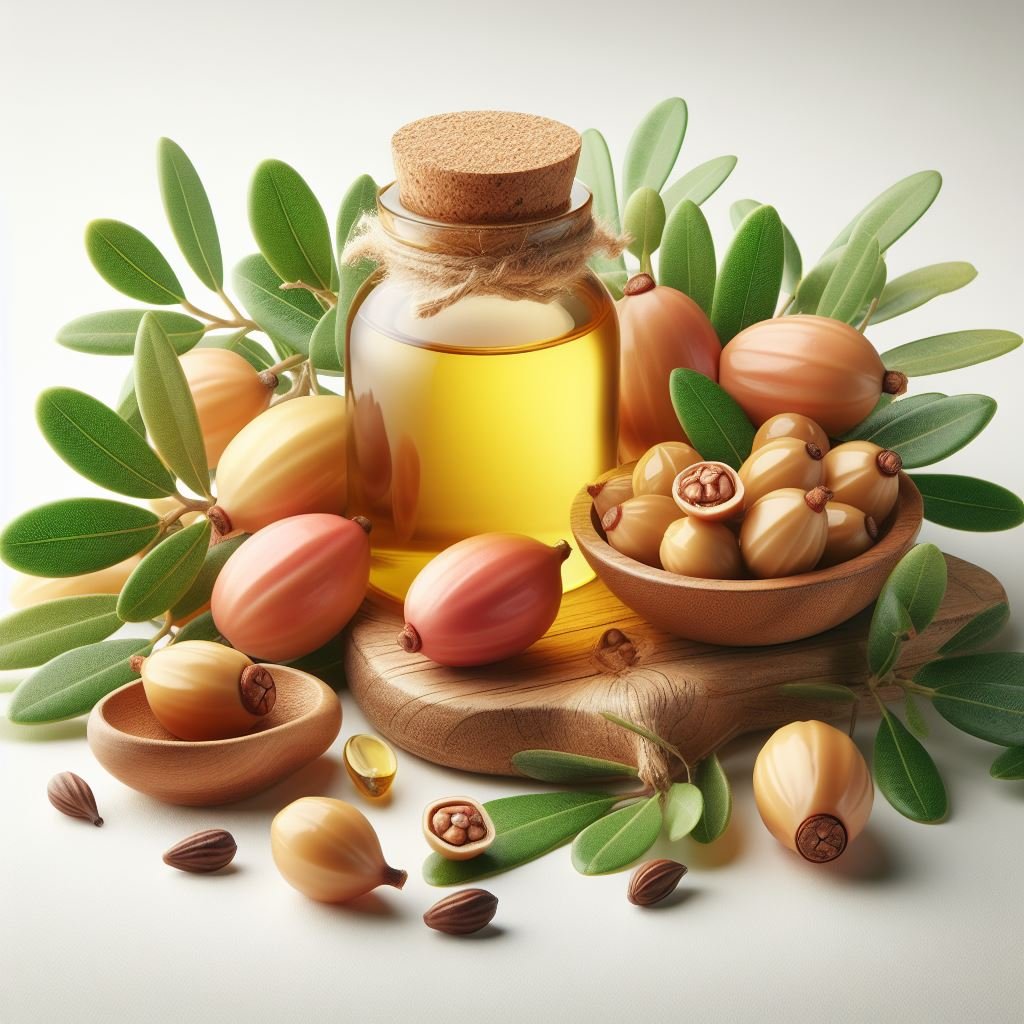Natural Jojoba Oil: A Miraculous Natural Solution for Skin and Hair Care
Natural Jojoba oil is a natural and versatile oil that has gained significant attention in the world of beauty and skincare. Actually a type of wax ester, this oil is extracted from the seeds of the jojoba plant and is particularly noted for its moisturizing properties for the skin, hair care, and anti-aging benefits. Its structure, similar to human skin’s sebum, makes jojoba oil particularly suitable for skin care. Rich in antioxidants, Vitamin E, and other nourishing components, jojoba oil boasts a wide range of applications from skin health to hair care. In this article, we’ll delve into the origins, composition, and versatile uses of Jojoba oil and how is Jojoba oil obtained …
The popularity of Natural Jojoba oil stems from its softening and reparative effects on the skin. The protective barrier it forms on the skin helps reduce the adverse effects of external factors, while making the skin appear more hydrated and vibrant. Additionally, it is known to be effective in treating skin problems such as acne and pimples. The impact of jojoba oil on hair is notable for moisturizing and adding shine, as well as preventing split ends. This natural wonder continues to be a preferred choice for both skin and hair care.
History and Origin of Jojoba Oil
The history and origin of this oil begin in the deserts of America. The jojoba plant (Simmondsia chinensis) is a long-lived, resilient shrub that naturally grows in the desert regions of North America. Its use dates back centuries, primarily by Native American tribes for medicinal purposes as well as for hair and skin care. Until the mid-20th century, the use of jojoba oil was largely confined to local applications. However, with the decline in the use of whale oil and the increasing search for natural, sustainable products, jojoba oil became a popular alternative in the cosmetic and pharmaceutical industries.
It is distinct from other vegetable oils due to its unique chemical structure. It is actually not an oil but a liquid wax, highly resistant to high temperatures and pressure. These properties make it a preferred ingredient in skin and hair care products. The cultivation of the jojoba plant and the extraction of its oil are carried out using environmentally sustainable methods, making jojoba oil an eco-friendly option. Today, this valuable oil has a wide range of applications in the cosmetic and health sectors worldwide.
Botanical Properties of Jojoba Plant:
Jojoba (Simmondsia chinensis), also known as goatnut, deernut, pignut, wild hazel, quinine nut, coffeeberry, and gray box, is a hardy evergreen shrub native to the Sonoran Desert of Arizona, California, and northwestern Mexico. It is the only species in the Simmondsiaceae family.
Botanical Properties
- Phylum: Tracheophyta (vascular plants)
- Class: Magnoliopsida (dicots)
- Order: Sapindales
- Family: Simmondsiaceae
- Genus: Simmondsia
- Species: chinensis
Physical Characteristics
- Height: 2–6 meters (6–20 feet)
- Stem: Gray-green, slightly woody
- Leaves: Alternate, oval to oblong, 1–5 cm (0.39–1.97 inches) long
- Flowers: Small, green-yellow, inconspicuous
- Fruit: A small, oval capsule containing 1–3 seeds
Ecology
Jojoba is a drought-tolerant plant that can survive in arid regions with little rainfall. It is also salt-tolerant and can grow in soils with high salinity. Jojoba is a pioneer species, meaning that it is one of the first plants to colonize disturbed areas. It is an important source of food and shelter for wildlife, including deer, coyotes, and birds.
How to Obtain Jojoba Oil?
From Seed to Oil: Demystifying the Journey of Jojoba Oil Extraction
This marvel oil, the elixir of beauty and nourishment, has captivated the hearts of skincare enthusiasts worldwide. Its remarkable ability to mimic the composition of our skin’s natural sebum, making it readily absorbed and beneficial to various skin types, has earned it a coveted spot in the realm of natural beauty products.
But how do we transform these tiny jojoba beans into the precious oil we so desire? The process of this oil extraction is a delicate dance between nature’s bounty and human innovation.
Harvesting the Bounty of the Desert
The jojoba plant, Simmondsia chinensis, thrives in the arid climates of Arizona, California, and Mexico. Its plump, teardrop-shaped seeds, containing an abundance of oil, are the source of our beloved jojoba oil.
Harvesting jojoba beans is a meticulous process, often carried out by hand to ensure the integrity of the seeds. Once collected, the beans undergo a thorough cleaning and drying process to remove any impurities and prepare them for extraction.
The Art of Cold Pressing
Cold pressing, a method that preserves the oil’s delicate composition, is the preferred technique for extracting jojoba oil. This process utilizes mechanical pressure to squeeze the oil from the dried jojoba beans, minimizing the heat exposure that can degrade the oil’s quality.
The cold-pressed natural jojoba oil, a golden liquid with a nutty aroma, is characterized by its high viscosity, similar to that of liquid wax. This unique characteristic contributes to its ability to mimic our skin’s natural sebum, making it a remarkable emollient and moisturizer.
The Refining Process
Before the jojoba oil is ready for commercial use, it undergoes a refining process to remove any impurities or sediments. This step involves filtering, centrifuging, and sometimes bleaching, ensuring the oil’s purity and maintaining its natural properties.
The refined natural jojoba oil, now crystal-clear and free of any impurities, is ready to embark on its journey to become a staple in skincare products, hair care treatments, and even a culinary delight in certain cultures.
The Value of Sustainable Practices
The jojoba oil industry prioritizes sustainable practices to ensure the long-term viability of jojoba cultivation and extraction. This includes responsible farming methods that protect the surrounding environment and promote biodiversity.
By adhering to sustainable practices, the jojoba oil industry ensures the continued production of this precious oil while preserving the delicate ecosystems that support its cultivation.
From Seed to Skin: The Enduring Legacy of Jojoba Oil
The journey of this oil, from its humble beginnings as a tiny desert bean to its transformation into a sought-after beauty essential, is a testament to nature’s bountiful gifts and human ingenuity. Cold pressing, refining, and sustainable practices ensure that jojoba oil remains a symbol of purity, nourishment, and beauty for generations to come.
What Beneficial Vitamins and Minerals are in Jojoba Oil?
It is a rich source of vitamins and minerals that provide numerous benefits for skin and hair health. Here’s a breakdown of the key vitamins and minerals found in jojoba oil:
Vitamins:
- Vitamin E: This potent antioxidant helps protect skin cells from damage caused by free radicals, reducing the risk of premature aging and wrinkles. It also plays a crucial role in maintaining skin elasticity and hydration.
- Vitamin B: It contains several B vitamins, including vitamin B1, B2, B3, and B6. These vitamins contribute to skin cell regeneration, collagen production, and overall skin health.
Minerals:
- Copper: Copper aids in melanin production, which protects skin from sun damage and promotes healthy skin pigmentation. It also helps maintain collagen levels and strengthens skin tissues.
- Zinc: Zinc plays a vital role in wound healing and skin cell regeneration. It also helps regulate sebum production, keeping skin balanced and preventing acne breakouts.
- Selenium: Selenium is a powerful antioxidant that protects skin cells from free radical damage, reducing inflammation and promoting skin health.
- Chromium: Chromium helps regulate blood sugar levels, which can impact skin health. It also supports collagen production and promotes healthy skin elasticity.
Other Nutrients:
- Wax esters: These wax esters are the main components of this fabulous oil, making up about 90% of its content. They mimic the natural composition of human sebum, providing superior skin hydration and moisturization.
- Sterols: Jojoba oil contains several sterols, including campesterone and stigmasterol. These sterols have anti-inflammatory and antimicrobial properties, which can benefit skin health.
- Flavonoids: Jojoba oil contains flavonoids, such as quercetin and kaempferol. These flavonoids act as antioxidants, protecting skin cells from damage and promoting overall skin health.
These vitamins, minerals, and other nutrients in jojoba oil contribute to its wide range of benefits for skin and hair care. It’s a natural and gentle product that can be used for a variety of purposes, from moisturizing skin and reducing wrinkles to promoting healthy hair growth and preventing breakage.













Reviews
There are no reviews yet.